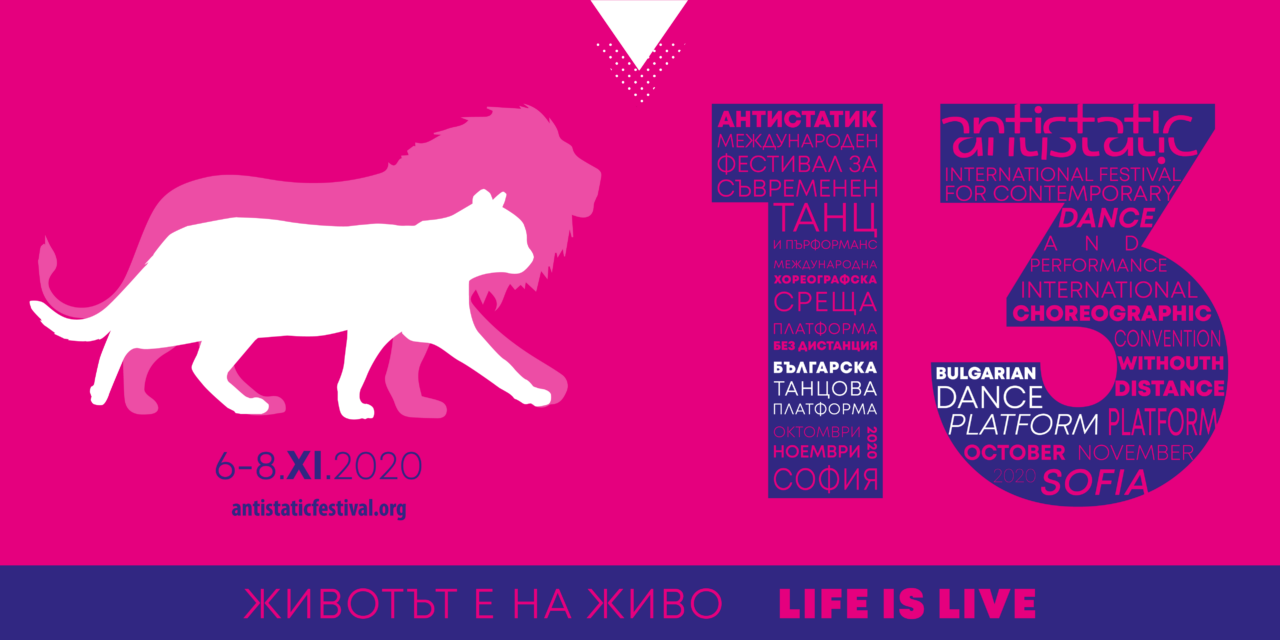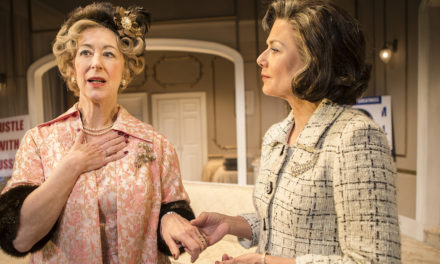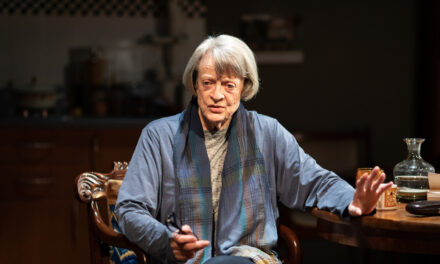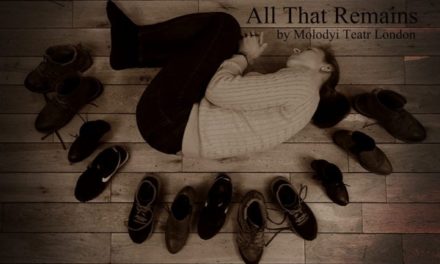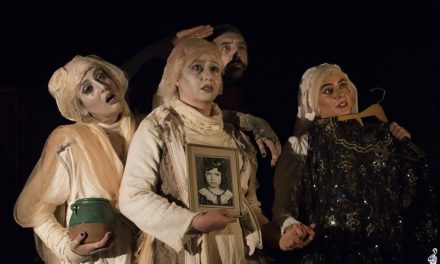As the second wave of the pandemic was just gaining speed in the country, in between the worrying rise in new infections and the necessary tightening of restrictions, almost miraculous from 6th through 8th of November the second Bulgarian Dance Platform of Antistatic International Festival for Contemporary Dance and Performance was held as a part of the festival’s 13th edition.
In the span of a bit more than 50 hours at five different venues across Sofia, the platform presented recent works of 14 emerging and established Bulgarian choreographers. They include (in alphabetic order): Aleksandar Georgiev, Anna Dankova, Darío Barreto Damas, Galina Borissova, Iva Sveshtarova, Ivo Dimchev, Jivko Jeliazkov, Marion Darova, Mila Iskrenova, Rossen Mihailov, Stephan A. Shtereff, Stephanie Handjiiska, Willy Prager and Zhana Pencheva. Without claiming exhaustiveness, the program managed to include a substantial variety of artists from different generations, career stages, dramaturgical and bodily approaches, artistic missions and esthetics. It represented most, if not all, of the active and visible makers on the contemporary performing art scene in the country today.
One way to dive and swim through the kaleidoscope of diverse artists’ signatures available during these intense three days is to look at the topics touched upon and to see what subject matters provoke the choreographic imagination. In other words, what does the contemporary performing arts scene in Bulgaria find important and want to talk about? The answer appears to lead in two general directions.
Among the major artistic stimuli, there seems to be the need to dissect, discuss, question and – in some cases – even deconstruct contemporary cultural notions and understanding, or sharpen attention onto global issues and trends. Half of the 13 events shown embarked on their artistic journey from such a predicament.
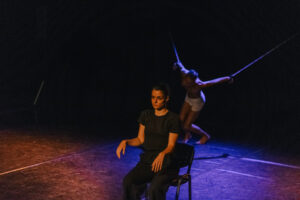
Photo: Teodora Simova
The Bulgarian Dance Platform program began with Corpus Meum by the young choreographer Marion Darova. With this movement-based piece, she claims to offer an “alternative to the failed public debate on the subject of dignified death, which sometimes is the only way to overcome extreme bodily suffering”. On stage, the three emerging performers – Tsveta Doycheva, Vasilia Drebova and Bratan Bratanov – illustratively embody the suffering of a dying person and his close ones by representing the situation, when this person oscillating above the edge of life, is literarily crucified by his or her condition and by those surrounding them, who are both their loved ones and wider society.
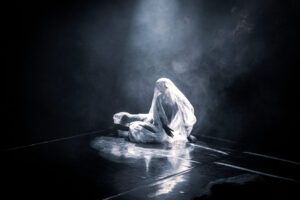
Photo: Teodora Simova
Employing similar black-and-white esthetics in the stage design, established choreographer Jivko Jeliazkov visualizes the negative effects of human behavior, overconsumption and use of polyethylene that suffocate our planet with his performance, Synthetics. He chooses the experiences of the already struggling creatures as his focal point. They are represented by young performers Elitsa Popova, Mihaela Zaimova, Radina Harizanova, who are grouped together most of the time – as endangered beings would be in order to survive – in the middle of the stage. Situated there, they are lower than the audience, thus remain faceless underneath the big chunks of plastic film covering them that they fight off.
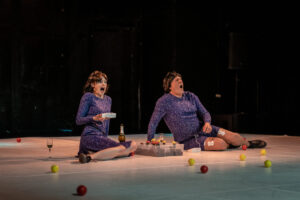
Photo: Teodora Simova
On the other end of the emotional spectrum, but still zooming in on things we often take for granted and leave unquestioned, the renowned artistic duo Iva Sveshtarova and Willy Prager take a closer look at the understanding of happiness with Made for Happiness. Condensing recommendations from the flourishing industry of self-help guides into easily recognizable objects, like stress balls and glasses of Champagne, they eagerly set off to “produce” this much-desired state of being in their performance. The result is a pleasant artistic experience charged with healthy sense of humor, which easily destabilizes the idea of happiness as being a single entity, with equal meaning for every individual. Thus, it exposes how tiring the whole galloping quest to “be happy” can out to be.
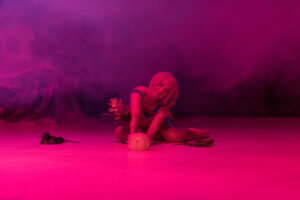
Photo: Teodora Simova
With her choreographic concert entitled Six Love Songs, choreographer and performer Zhana Pencheva reflects on familiar understandings of love and intimacy. To that purpose, she takes up the role of a kind and seductive hostess, creating the atmosphere of a date between her and the audience. Naturally, it all happens under bright pink lights, glitter, curls of smoke and the original music of Tsvetan Momchilov, who also performs.
However, two productions really stand out in this group of works with their elaborate combination between subject matter chosen and a multilayered artistic approach to it. Perfectly Pink is a piece created by Iva Sveshtarova, who teams up with another prominent Bulgarian performer and choreographer on stage, Violeta Vitanova. The performance approaches women’s issues from a very important and honest – but often overshadowed – perspective, by carefully exploring how women actually feel subjectively. They get under their skins in the emotional and intellectual roller-coaster of the present day, which do not provide a possibility to get down. Through a long chain of different, prudently built scenes with increasing emotional density, the performance methodologically and powerfully reveals the range of emotional amplitudes that women’s’ bodies and minds pass through in what can be thought to be a single solar day. That includes being able to execute what is traditionally thought of as masculine activities, which are depicted in their extreme in the performance, with the two performers fearlessly cutting wood and using angle grinders on the stage. At the same time, they keep up with stereotypically womanly domains like cooking, seducing, witchcraft, and being crazy, frivolous, playful, weak. Those episodes, montaged tightly together in the performance, show in a witty way that women’s difficulties and frustrations do not arise from any single one of those activities or states on its own. Instead, they arise from the requirement that they be practiced together, often simultaneously, without a possibility of a break or an exit.
“Soft Questions” is by the young choreographer Stephanie Handjiiska, who decides to explore the social meaning of success in our contemporary culture. She does that by steadily but delicately tracking down two parallel lines and intertwining them, when necessary. On one hand, she pays attention to what we celebrate as inspiring success stories by mounting up examples from pop-culture, like Beyoncé, Nobel laureates and politicians. Simultaneously, she follows how inner logic, fueled by those examples, resonates on a personal level, within the biographies of the different ordinary people, including the artist herself. To that end, the performance begins with a mini-installation, in which Handjiiska, covered with post-it notes, acts as a bodybuilder or a celebrity, guarded by muscular male. At the same time, a collage of recordings announcing world-famous achievements plays. Then, the artist transitions to the next part of the piece by involving a member of the audience. She asks to be taken to an armchair, situated at the other diagonal of the stage, closer to the audience. On the way, she asks her companion to talk about whom they considers the most successful person and why. This starts to diffract the notion of success into particular examples and gains momentum in the next part, when Handjiiska takes on the role of a speaker, directly telling the audience her own, invented life story full of great achievements. The setting clearly resembles familiar, popular public speaking formats used to share ideas. Every time the artist mentions a recognizable success, she awards herself a fake-looking medal, that way exposing the dullness of the notion itself.
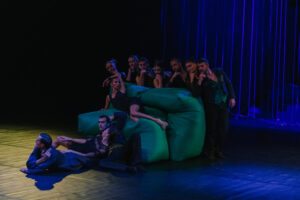
Photo: Teodora Simova
Another distinguishable group of works presented during the Bulgarian Dance Platform includes six productions driven by the quest to reexamine or reinvent prominent figures, artworks, or memories, which are either presently underestimated or allure to be revisited. Two of the most recognizable Bulgarian choreographers of the more mature artistic generation chose to build on Vaslav Nijinsky’s The Afternoon of a Faun. Mila Iskrenova’s performance of the same name applies Nijinsky’s elaboration on ancient paintings and sculptures in a poetic manner, resulting in a picturesque set of scenes. To add more poetry to the canvas of her piece, the original text of Mallarme’s poem is recited. It accompanies Claude Debussy’s music and the skillful performances by dancers from Arabesque Ballet Dance Company.
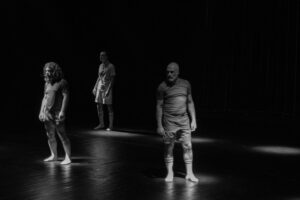
Photo: Teodora Simova
In Lunch On The Grass with a Faun, choreographer Rossen Mihailov takes a very different approach, focusing on the role of male dancers on the stage that Nijinsky’s piece introduced. That is why his work involves four male dancers – Aleksandar Georgiev, Stefan Vuchov, Stefan Kumanov and the choreographer himself – who have different backgrounds and professional training. He shows them moving through a wide range of masculine roles, spanning from everyday depictions to the sadomasochistic ending of the work.
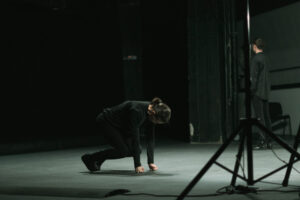
Photo: Teodora Simova
Also in this group of shows is Ada Lovelace by theater director Anna Dankova, which is a thoughtful experiment in expressing the inner life of Lord Byron’s daughter, who is considered as to be the first computer programmer. The performance easily withstands any temptation to tell the intriguing story of Ada as a narrative, and manages to contemplate bigger concepts and feelings. It floats between the mathematic rationality and poetic sensitivity of her imaginary, in a postdramatic, visual and physical way. The two performers – Iva Sveshtarova and Violeta Vitanova – represent the duality in this world, which the performance delicately shows, is also singular and monolithic on a higher level.
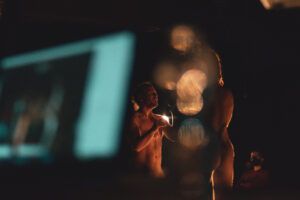
Photo: Teodora Simova
The choreographers/performers Aleksandar Georgiev and Darío Barreto Damas took the audience of the Bulgarian Dance Platform on their poetic journey Moonlight. In their words, “by playing around with Disney legacy, the performance offers a possibility to rediscover persistently established identities and to unfold normativity through queer practices.” Yet, this disruption happens softly, through a slowly altering phrasal repetition within the choreographic structure and the carefully implemented dramaturgy of the piece, which immerses the viewers in its modality.
Again, in this cohort of works, two pieces’ daring approach to their chosen subject left a significant impression. Another very poetic performance included in the program is the solo How Fast Life Flies from January to December by renowned choreographer Galina Borissova. Inspired by Virginia Woolf’s novel To the Lighthouse, this work gently and profoundly looks at the texture of daily life. It searches for the invisible cracks in routine that possess the potential to blow it up for a single second. It deceptively and intentionally feels as if little action happens, which directly contradicts the familiar convention of a performative moment. However, once the audience’s growing expectation of something to start is overcome, the piece begins to work. It is as if it is slowing down time and extending it, so the pulse of it passing can actually be heard in the room. With this aim, the artist welcomes the audience into the performance space and gradually involves everyone in the mundane, close, and nostalgic in just the right dose activities, like looking through old photos, studying antique objects and drinking tea. At the same time, Borissova, now wearing a stylish robe as one more item, reminiscing the spirit of Woolf’s world, adds new furniture, rearranges the space and asks “her guests” to change their seats. This makes it more and more cozy, and creates the allusion that everything moves leisurely but is never the same. The performance ends the same way it begins – without a clear indication when it happened, floating on as life does.
Nonument utilizes the format of a Radioballet that guides the audience through a prerecorded audio-play it listens to on headphones, while following the instructions received. Sometimes these are different for different people, sometimes they are the same for the whole group. The production is the third collaborative project between Bulgarian artists Stephan A. Shtereff and Emilian Gatsov-Elbi, and the German collective LIGNA. With it, they “step on” Buzludzha Peak in the Central Balkan Mountains, where in 1981 the architecturally futuristic and ideologically controversial House of the Bulgarian Communist Party was built. During the Bulgarian Dance Platform we saw the movie of the first presentation of the performance in September 2019. Remarkably, the piece looks into the quite contentious topic of memory and representation from a fresh and rejuvenating viewpoint. With poetic gentility and sought-after simplicity, it plays around with the possible thoughts of the building itself, looking at it both from a cosmic perspective and through the eyes of those approaching it from “below” today, vocalizing the possible pondering reflections of the individuals climbing the stairs to the building. That way the work manages to “uproot” with ease this monument from its layers of dust and the preconceptions about the highly charged with historical interpretations spot on the Bulgarian map, and to leave it hanging in the air almost as a tabula rasa ready to find its best meaning today.
The second Bulgarian Dance Platform of the Antistatic International Festival for Contemporary Dance concluded with Ivo Dimchev LIVE concert – the latest direction the ceaseless, artistic drive took the world-famous choreographer and performer in recent years. During lockdown in the spring of 2020, he began organizing private concerts in his car at the homes of his fans and in other private spaces and was invited to carry out grand-piano afternoon concerts at the ballroom of the National Art Gallery in Sofia. On stage, Dimchev performs compositions from his performances, together with newly written songs. Among the pieces he sung was “I-cure” from the soundtrack of his performance of the same title, created in 2014, from which the vocal phrase “washed and cleaned by its amazing energy” stuck in the air with its exquisiteness and echoed endlessly as a nice summary of the spirit of the Bulgarian Dance Platform.
This text was written as part of “Zoom In / Приближаване” individual project of the author,
supported by the National Culture Fund of Bulgaria
This post was written by the author in their personal capacity.The opinions expressed in this article are the author’s own and do not reflect the view of The Theatre Times, their staff or collaborators.
This post was written by Ina Doublekova.
The views expressed here belong to the author and do not necessarily reflect our views and opinions.

